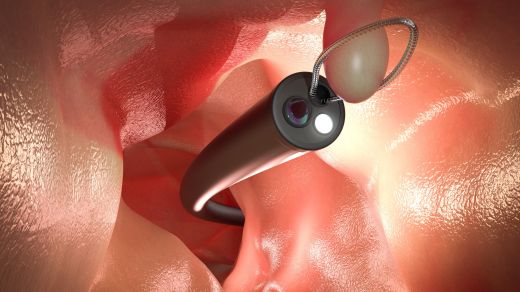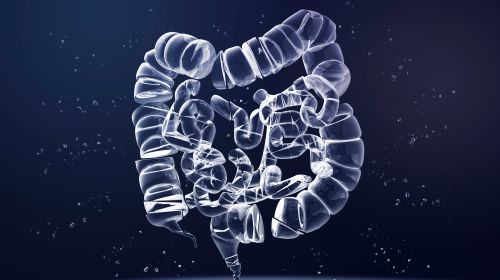Intestinal polyps are benign changes in the intestinal lining. Type, size and shape can vary. Most polyps are benign adenomas. Read about whether colon polyps cause symptoms and why you should have them removed.
- © phonlamaiphoto – stock.adobe.com
Quick overview: Frequently asked questions and answers
How do you know if you have colon polyps? Often polyps in the intestines do not cause any symptoms, but they can occasionally cause blood in the stool, unexplained abdominal pain, or changes in bowel habits.
How dangerous are colon polyps? Not all are dangerous, but some types can develop into colon cancer if not removed in a timely manner.
How long does it take for a polyp to become malignant? The development of polyps into cancer is a slow process that can take many years, depending on the type of polyp and other individual risk factors.
When do colon polyps need to be removed? They are usually removed during a colonoscopy. Especially if they are over a centimeter in size or have other suspicious features.
Article contents at a glance:
What are intestinal polyps?
Intestinal polyps (colorectal polyps) are small growths that arise on the lining of the intestinal wall. They can look like small bumps or stalks and are usually benign. The most common forms are adenomas, which occur primarily in the large intestine. Since adenomatous cells can degenerate, they are considered a precursor to colon cancer. This is particularly true if they consist of glandular tissue from the colon mucosa.
With increasing age, the likelihood of polyp development increases. In Germany, around 20 percent of people over 60 have such tumors in their intestines. Men and women are affected equally often.
Causes of polyps in the intestines
It is not yet clear which causes are responsible for the development of intestinal polyps. A genetic predisposition is suspected because intestinal polyps usually run in families.
Diet also seems to play a role. High-fat, low-fiber foods in particular are suspected to be triggers. In addition, there is excessive consumption of alcohol and nicotine and the consumption of red meat.
Certain hereditary diseases lead to polyps
In the hereditary disease familial adenomatous polyposis (FAP), numerous polyps develop in the intestine at a young age. These polyps are adenomatous and have the potential to develop into colon cancer. Almost all patients with FAP develop colon cancer by the age of 40 without appropriate treatment.
Peutz-Jeghers syndrome is a rare genetic disorder characterized by the appearance of numerous benign polyps in the stomach, small intestine and large intestine. Dark pigment spots on the skin and oral mucosa are also characteristic.
Typical symptoms of intestinal polyps
In most cases, intestinal polyps cause little discomfort. That is why they are more likely to be discovered by chance when examinations are carried out for other complaints. Intestinal polyps rarely cause non-specific symptoms such as:
- flatulence,
- stomach pain and
- Changes in bowel habits (such as persistent diarrhea or constipation).
Occasionally, polyps in the intestines also cause blood in the stool. Depending on the extent and duration of the bleeding, anemia (anemia) can develop. This is manifested by general weakness, tiredness and pale skin. Other symptoms may include shortness of breath, dizziness or headaches.
Intestinal polyps: symptoms, causes and when to remove them?
Diagnosis by colonoscopy
Colon polyps are usually discovered accidentally during a colonoscopy. The advantage of the procedure is that doctors can take a sample (biopsy) directly and then have the tissue examined in the laboratory. In this way, possible degeneration of the cells is detected at an early stage.
Larger intestinal polyps can be easily identified by examining blood in the stool, but this method is rather unreliable for smaller polyps.
Treatment: Remove intestinal polyps surgically
Therapy for intestinal polyps includes their complete removal. They are removed during surgical removal (polypectomy). This usually happens during a colonoscopy: a loop of wire is inserted into the intestine through the endoscope. Electricity is then passed through the loop, making it easy to remove the polyps. At the same time, the blood vessels are closed.
To reduce the risk of colon cancer, colon polyps that are discovered should always be removed. Particularly large polyps and cases of colon cancer within the family are considered risk factors. It takes between five and ten years for a colon polyp to develop into colon cancer.
Follow-up care for intestinal polyps
People who have already had intestinal polyps diagnosed and removed have a higher risk of developing adenomas again and should therefore be examined regularly. If no malignant cells were found in the removed intestinal polyp, a colonoscopy is recommended to check after three to five years. If no new polyps have appeared, the following check-up in five years is sufficient.
However, if malignant cancer cells were found in the removed polyp, a colonoscopy should be carried out after six months to check.
Prevent polyps in the intestines
It is believed that lifestyle plays a role in the development of benign changes in the intestine:
This particularly affects eating habits.
Obese people have a greater risk of developing colon polyps.
But even people of normal weight can get polyps, especially if they eat a diet high in fat and low in fiber.
It is therefore advisable to eat a diet rich in fiber and low in fat as a preventive measure.
It also makes sense to limit your consumption of beef and pork and prefer poultry.
Exercise and avoiding alcohol and nicotine also have a positive effect. This is particularly true for people who have polyps in the colon or a family history of colon cancer. In these cases, regular preventive examinations are also recommended.


